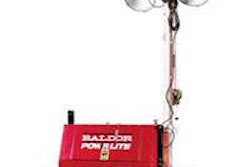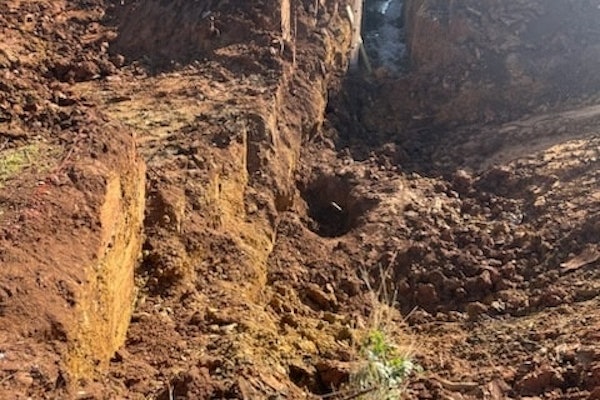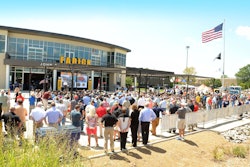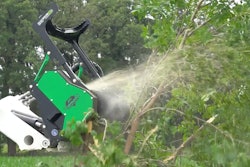Lebanon, OH After nearly 15 years in the land clearing and brush cutting business, Mark Lee figured that he™d seen and done about every type of project imaginable. He™s cleared rights-of-way for utilities, thinned underbrush to reduce fire hazards, cleared land for residential and commercial construction…you name it and mark Lee and his Hydro Cut teams have done it. And then the call came to clear a swath of land so that a historic home could be moved to a new location.
In a culture where our mammoth concrete sports facilities are outdated and in need or replacement after 2 decades it might seem strange to move a home that is hundreds of years old. But this wasn™t just any home Midway Plantation is listed on the national Historic Register because of its historical importance. Midway was built in 1848 on a wagon trail between Tarboro and what would become Raleigh, NC. The road eventually became Highway 64 East a 4-lane highway connecting eastern North Carolina and the capital. With the completion of the Outer Loop, I-540, thousands of people would not only pass through the area but many businesses and homes would be built. Eventually, the owners sold a developer who built a shopping mall to the area. To maintain the home Charles Silver and his wife Dena embarked on a project to move the home through 3 miles of varied terrain which included a working quarry.
Mulching A Pathway to Success
One of the first steps in moving the home was to determine the route. While there are existing roads which might be easier to traverse, the downside to this option was the cost. Lowering a single power line and then re-erecting it once the caravan had passed by would have cost $35,000. Multiply that by the countless obstacles that would have to be temporarily displaced to move the 280 ton structure through 5 miles of roadway and the costs quickly reach into the millions.
A more direct route was available, but this meant blazing a trail through 3 miles of varied terrain. In addition to a quarry, the path crossed through long stretches of heavily forested areas nearly 2 miles through hardwoods, pines and even some wetlands. This is where Mark Lee and his Hydro Cut team enter the picture. They saved not only time, but cold hard cash as well as the mulched pathway route cost approximately $1 million.
Ecological Effects of Mulching
With a host of land clearing machines, Hydro Cut is well equipped for a challenge like this. Rather than bulldoze the trees, which would require filing for and waiting for approval on permits, Lee and his crew used their 7 grinders to chew through the standing trees some to 30-inches in diameter, brush and vegetation. Mulcher heads were mounted on a diverse array of carriers including tracked excavators, Hydro-Axe carries, skid steer loaders, and more. Regardless of the carrier, the only residue once they were finished was a carpet of mulch which the house movers could easily drive over.
The path was 100 feet wide in most spots recalls Lee and 150 feet wide at the turns. Vegetation encountered was pretty typical for the region including both hardwoods and softwoods, with very dense thickets of undergrowth interspersed throughout the project. Mulching the vegetation proved to be much less invasive and less destructive to the grund than dozing the trees, or cutting them and then hauling away. Leaving the felled trees on site was not an option for both aesthetic reasons and practical ones the downed trees would have been ideal forest fire fuel. All told the mulching project took around 3 weeks to complete and required no permits or special considerations.
After the house movers snaked their way through the path, the mulched material stayed on the ground to prevent erosion. As the woody debris decays, it adds nutrients back into the soil, increasing its tilth and vitality yielding both short-term and long-term benefits.
Not only is Lee sold on mulching rather than dozing, he is also sold on his fixed tooth Fecon cutter heads. I™ve tried about every head out there and the biggest advantage of the Fecon is its durability says Lee. Durability is certainly important whether you are blazing a trail for grandmother™s house or clearing power lines. Because the last thing any contractor wants is trouble especially in remote areas where Lee and his crew often find themselves.
Part of that durability is in the tooth design itself. You might think that teeth which spend their entire life gnawing through the Carolina woods would have a relatively short life but that is not the case. Lee figures his teeth typically last from 400 to 600 hours. He™s had to replace some in as little as 300+ hours while one set ran for 720 hours. If you can keep them out of the rocks and abrasive clay muses Lee, the teeth wear a long time.
A Mulching Business Born of Necessity
Mark Lee has been in the mulching business for over 15 years. Many of his operators have been with him for much of that time the average tenure being 10+ years. While he cannot think of anything he™d rather do for a living, he actually got into the mulching business out of necessity almost by accident.
His father owned some property along the Neuse River in eastern NC. They wanted to clean up the property but were not allowed to use traditional dozers due to permitting restrictions. So they bought a mulcher out of necessity. Someone else saw us working and asked if we could clear some of their land, and next thing we know we™re in the mulching business recalls Lee. That mulching business has completed all kinds of projects including moving grandmother™s house over the river and through the woods.











